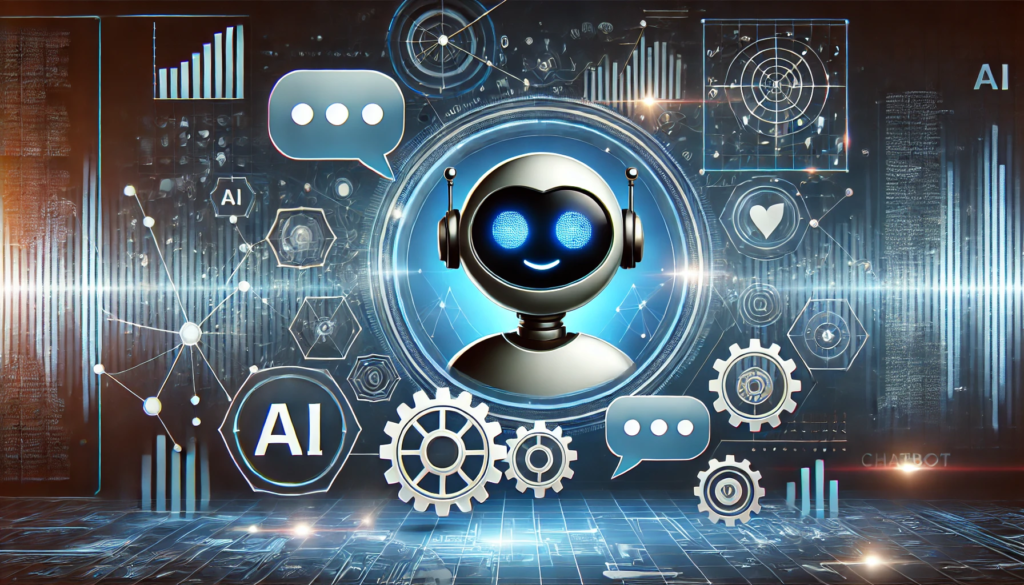Key Takeaways
- Chatbot software automates conversations using AI, NLP, and rule-based systems to enhance customer support and business efficiency.
- It works by processing user queries, generating responses through predefined rules or machine learning for dynamic interactions.
- Future advancements in AI-driven chatbots will improve personalization, sentiment analysis, and integration with voice and multimodal interfaces.
In today’s digital landscape, businesses are constantly seeking innovative ways to enhance customer interactions, streamline operations, and improve efficiency.
One of the most transformative technologies in this space is chatbot software.
With the rise of artificial intelligence (AI) and natural language processing (NLP), chatbots have become an essential tool for businesses across various industries, enabling seamless and automated communication between companies and their customers.

Chatbot software serves as a virtual assistant, capable of handling customer inquiries, providing instant responses, and even completing transactions—all without human intervention.
From customer service and e-commerce support to healthcare consultations and financial advisory, chatbots are revolutionizing how businesses engage with users.
Companies leverage these AI-driven solutions to ensure round-the-clock support, enhance user experience, and reduce operational costs, making them a crucial component of digital transformation.
The growing reliance on chatbot software is driven by the increasing demand for automation and personalization.
Consumers today expect fast, accurate, and efficient responses to their queries, and chatbots are designed to meet these expectations.
Whether it’s a simple rule-based chatbot that follows predefined scripts or an advanced AI-powered chatbot capable of understanding complex conversations, these virtual assistants are reshaping customer interactions at an unprecedented scale.
But how exactly does chatbot software work?
At its core, chatbot technology involves a combination of AI algorithms, machine learning, and NLP to interpret user queries, process data, and generate appropriate responses.
These bots can operate on multiple platforms, including websites, mobile apps, social media channels, and messaging applications like WhatsApp, Facebook Messenger, and Slack.
By integrating chatbot software into their systems, businesses can automate repetitive tasks, optimize workflows, and enhance customer satisfaction, leading to improved brand loyalty and revenue growth.
As chatbots continue to evolve, they are becoming more sophisticated, offering personalized recommendations, multilingual support, and voice-enabled interactions.
This shift highlights the growing importance of AI-driven communication tools in shaping the future of customer engagement.
In this blog, we will delve deeper into chatbot software, exploring its definition, working mechanisms, key features, benefits, challenges, and future trends.
Whether you are a business owner looking to implement chatbot technology or a tech enthusiast curious about how these digital assistants function, this comprehensive guide will provide valuable insights into the world of chatbot software and its transformative impact.
Before we venture further into this article, we would like to share who we are and what we do.
About 9cv9
9cv9 is a business tech startup based in Singapore and Asia, with a strong presence all over the world.
With over nine years of startup and business experience, and being highly involved in connecting with thousands of companies and startups, the 9cv9 team has listed some important learning points in this overview of How to Find and Hire Employees in New Mexico, USA in 2025.
If your company needs recruitment and headhunting services to hire top-quality employees, you can use 9cv9 headhunting and recruitment services to hire top talents and candidates. Find out more here, or send over an email to [email protected].
Or just post 1 free job posting here at 9cv9 Hiring Portal in under 10 minutes.
What is Chatbot Software and How It Works
- What is Chatbot Software?
- How Does Chatbot Software Work?
- Key Features of Chatbot Software
- Benefits of Using Chatbot Software
- Challenges and Limitations of Chatbot Software
- Future Trends in Chatbot Software
1. What is Chatbot Software?
Chatbot software is an AI-powered application designed to simulate human-like conversations with users, enabling automated interactions across various digital platforms. These virtual assistants are widely used in customer service, sales, marketing, healthcare, and numerous other industries to streamline communication, enhance user engagement, and improve operational efficiency.
Depending on their complexity, chatbots can operate using predefined rules or leverage artificial intelligence (AI) and natural language processing (NLP) to interpret and respond to user queries dynamically. They function across multiple channels, including websites, mobile apps, social media platforms, and messaging applications such as WhatsApp, Facebook Messenger, and Slack.
Key Characteristics of Chatbot Software
1. Definition and Core Functionality
- A chatbot is a software application that interacts with users through text or voice-based conversations.
- It uses either scripted responses or AI-driven models to answer queries, provide recommendations, and assist users in real time.
- Chatbots help businesses automate repetitive tasks, ensuring efficiency and reducing human workload.
2. Evolution of Chatbots: From Rule-Based to AI-Powered Assistants
- Early Chatbots (1960s-2000s)
- The first chatbot, ELIZA, was developed in the 1960s to simulate human-like conversations based on predefined scripts.
- Later chatbots, such as ALICE (Artificial Linguistic Internet Computer Entity) in the 1990s, incorporated pattern-based recognition to provide responses.
- Rise of AI-Powered Chatbots (2010s-Present)
- With advancements in machine learning and NLP, AI-driven chatbots like Apple’s Siri (2011) and Amazon’s Alexa (2014) revolutionized human-computer interactions.
- Today, chatbots integrate with Google Assistant, Microsoft’s Cortana, and OpenAI’s ChatGPT, offering highly intelligent, contextual, and adaptive responses.
Types of Chatbots
Chatbots are categorized based on their functionality and complexity. The two main types are:
1. Rule-Based Chatbots (Scripted Chatbots)
- Operate based on predefined decision trees and response patterns.
- Can only answer specific queries for which they are programmed.
- Limited in understanding complex or ambiguous questions.
- Used for basic customer support, FAQs, and automated workflows.
- Example:
- Banking chatbots for balance inquiries and transaction tracking.
- E-commerce bots that help users check order statuses.
2. AI-Powered Chatbots (Conversational Chatbots)
- Utilize machine learning, NLP, and deep learning to understand user intent and provide more natural responses.
- Continuously learn from user interactions, improving accuracy over time.
- Capable of handling complex queries, engaging in contextual conversations, and personalizing responses.
- Example:
- ChatGPT by OpenAI, which generates human-like responses based on AI models.
- Google Assistant and Alexa, which use voice recognition and AI to assist users with various tasks.
3. Hybrid Chatbots
- Combine rule-based logic with AI capabilities to offer structured yet intelligent interactions.
- Can handle basic queries while also learning from user data for better responses.
- Example:
- E-commerce customer support bots that use predefined scripts but also leverage AI for personalized recommendations.
Industries Leveraging Chatbot Software
Chatbot software has been widely adopted across various industries due to its ability to automate customer interactions and enhance efficiency.
1. E-Commerce and Retail
- Chatbots assist in product recommendations, order tracking, and customer support.
- Improve user experience by offering personalized shopping assistance based on browsing history.
- Example:
- Sephora’s chatbot provides beauty product recommendations based on user preferences.
2. Customer Service
- Used by businesses to automate responses to FAQs and provide 24/7 support.
- Reduce wait times and enhance user satisfaction with instant assistance.
- Example:
- H&M’s chatbot helps users find clothing items based on style preferences.
3. Healthcare
- Assist in scheduling appointments, providing medical advice, and monitoring symptoms.
- Help reduce the burden on healthcare professionals by handling preliminary consultations.
- Example:
- Babylon Health’s chatbot provides AI-powered health assessments.
4. Banking and Finance
- Used for balance inquiries, fraud alerts, and financial planning assistance.
- Improve customer engagement with automated reminders and transaction updates.
- Example:
- Bank of America’s chatbot, Erica, assists customers with financial queries.
5. Travel and Hospitality
- Assist in flight bookings, hotel reservations, and travel recommendations.
- Enhance customer satisfaction by providing real-time updates on travel schedules.
- Example:
- KLM Royal Dutch Airlines’ chatbot provides flight updates and booking confirmations.
Why Chatbot Software is Essential for Businesses
The adoption of chatbot technology is accelerating due to its ability to improve efficiency, boost customer satisfaction, and reduce operational costs.
1. Enhances Customer Experience
- Provides instant responses to user queries without long wait times.
- Offers a personalized experience by remembering user preferences and past interactions.
2. Automates Repetitive Tasks
- Reduces the workload on human agents by handling common queries.
- Frees up employees to focus on more complex, high-value tasks.
3. Ensures 24/7 Availability
- Unlike human agents, chatbots operate round the clock, ensuring uninterrupted customer service.
4. Improves Business Scalability
- Capable of handling thousands of simultaneous conversations, making them ideal for growing businesses.
5. Reduces Operational Costs
- Cuts down expenses associated with hiring and training customer support teams.
- Saves businesses millions of dollars annually by automating customer interactions.
Final Thoughts
Chatbot software has emerged as a game-changer in the digital age, transforming the way businesses interact with their customers. From simple rule-based bots to sophisticated AI-driven assistants, chatbots have proven their value in multiple industries, driving efficiency, reducing costs, and enhancing user engagement. As AI continues to evolve, the future of chatbot technology holds even more promising advancements, making it an indispensable tool for businesses worldwide.
2. How Does Chatbot Software Work?
Chatbot software operates by simulating human-like conversations using predefined rules, artificial intelligence (AI), and natural language processing (NLP). It interprets user inputs, processes them, and generates appropriate responses based on structured algorithms or machine learning models. The sophistication of a chatbot depends on its underlying technology, ranging from simple rule-based bots to advanced AI-driven conversational agents.
To understand how chatbot software functions, it is essential to break down the core components that enable seamless and intelligent interactions.
Core Components of Chatbot Software
1. Natural Language Processing (NLP)
- Definition: NLP is a branch of AI that enables chatbots to understand, interpret, and generate human language.
- Functionality:
- Breaks down user inputs into meaningful components.
- Analyzes language patterns to determine user intent.
- Generates appropriate responses based on context and previous interactions.
- Example:
- Google Assistant and Siri leverage NLP to recognize voice commands and provide relevant responses.
2. Machine Learning (ML) and Artificial Intelligence (AI)
- Definition: Machine learning allows chatbots to improve responses over time by learning from previous interactions.
- Functionality:
- Uses AI models to analyze user behavior and adapt to different conversational scenarios.
- Enhances accuracy by continuously updating its knowledge base.
- Personalizes responses based on user preferences and past interactions.
- Example:
- ChatGPT by OpenAI improves over time by learning from millions of conversations.
3. Intent Recognition and Entity Extraction
- Intent Recognition:
- Identifies the purpose behind a user’s query (e.g., booking a flight, checking account balance).
- Uses NLP models to classify user inputs into predefined categories.
- Entity Extraction:
- Detects specific keywords such as names, dates, locations, and product details to refine responses.
- Example:
- A banking chatbot detects the intent behind “What is my account balance?” and extracts the entity “account balance” to fetch relevant data.
4. Chatbot Backend and Processing Engine
- Definition: The backend system processes user inputs, retrieves information, and formulates responses.
- Components:
- Conversation Flow Management: Determines how the chatbot should respond based on predefined rules or AI predictions.
- Integration with Databases and APIs: Connects with external systems to fetch real-time data (e.g., user accounts, order details).
- Context Awareness: Maintains a history of previous interactions to ensure smooth and relevant conversations.
- Example:
- Amazon’s Alexa retrieves data from third-party APIs to provide weather updates or play music based on user commands.
5. Response Generation and Delivery
- Definition: The chatbot formulates a response based on user input and delivers it in the most effective format.
- Response Types:
- Text-based responses (e.g., FAQs, customer support).
- Voice responses (e.g., virtual assistants like Siri and Alexa).
- Multimedia responses (e.g., sending images, videos, or interactive buttons).
- Example:
- E-commerce chatbots display product recommendations as interactive carousels in chat windows.
Step-by-Step Process: How Chatbot Software Works
1. User Input Processing
- The chatbot receives input from users in text or voice format.
- It identifies the language, tone, and keywords to understand the query.
2. Intent Recognition and Context Understanding
- Uses NLP models to determine user intent (e.g., placing an order, checking status).
- Recognizes contextual information from previous conversations to provide relevant responses.
3. Data Retrieval and Decision Making
- If the chatbot is connected to a database, it fetches relevant data based on the query.
- For AI-driven bots, machine learning algorithms generate a response based on past training data.
4. Response Generation and User Interaction
- The chatbot formulates a response, ensuring clarity and relevance.
- If needed, the chatbot provides additional suggestions, follow-up questions, or escalation options to human agents.
5. Learning and Continuous Improvement
- AI-powered chatbots analyze interactions to enhance response accuracy.
- Machine learning algorithms refine future interactions based on user feedback and conversation history.
Types of Chatbot Workflows
Chatbots operate using different workflows depending on their complexity and function.
1. Rule-Based Workflow (Scripted Chatbots)
- Follows a predefined conversation structure.
- Uses decision trees to guide users through a fixed set of responses.
- Best for answering FAQs and basic queries where responses are predictable.
- Example:
- A restaurant chatbot that allows customers to choose a menu category and place an order through button-based navigation.
2. AI-Powered Conversational Workflow
- Uses NLP and machine learning to understand user intent and generate adaptive responses.
- Capable of handling complex, free-flowing conversations.
- Continuously improves by learning from past interactions.
- Example:
- Google Assistant processes open-ended queries such as “What is the best movie to watch this weekend?” and provides dynamic recommendations.
3. Hybrid Workflow (AI + Rule-Based)
- Combines scripted responses with AI-driven learning for a more flexible chatbot experience.
- Provides structured guidance while adapting to unexpected queries.
- Example:
- E-commerce chatbots that offer pre-set product categories but also handle natural language queries like “Show me the best winter jackets.”
Real-World Examples of Chatbot Software in Action
1. Customer Support Chatbots
- Example: Zendesk AI Chatbot handles customer inquiries, reducing response times.
2. Virtual Assistants
- Example: Siri, Google Assistant, and Alexa provide hands-free voice interactions for daily tasks.
3. Banking and Finance Chatbots
- Example: Erica by Bank of America assists customers with banking transactions and financial insights.
4. E-commerce Chatbots
- Example: H&M’s chatbot suggests clothing items based on user preferences.
5. Healthcare Chatbots
- Example: Babylon Health provides AI-driven health consultations and symptom analysis.
Challenges in Chatbot Functionality
Despite their advantages, chatbots face certain challenges that impact their performance.
1. Limited Understanding of Complex Queries
- AI chatbots struggle with ambiguous or slang-based conversations.
2. Dependency on Training Data
- The accuracy of AI-driven chatbots depends on the quality and diversity of their training data.
3. Integration Complexity
- Businesses may find it challenging to integrate chatbots with legacy systems and databases.
4. Handling Sensitive Data
- Chatbots dealing with financial or medical information must adhere to strict security protocols.
Final Thoughts
Chatbot software operates through a combination of NLP, AI, and machine learning to deliver seamless and automated conversations. From intent recognition to response generation, chatbots leverage advanced algorithms to improve user experience, automate customer service, and optimize business operations. As AI technology continues to evolve, chatbot software is expected to become even more intelligent, offering hyper-personalized interactions across various industries.
3. Key Features of Chatbot Software
Chatbot software has evolved into a sophisticated tool capable of automating conversations, improving user engagement, and enhancing business operations. The effectiveness of chatbot software depends on its core features, which enable it to understand, process, and respond to user queries efficiently.
Below are the key features that define high-quality chatbot software, along with relevant examples where applicable.
1. Natural Language Processing (NLP) and Understanding (NLU)
1.1 Advanced NLP Capabilities
- Enables chatbots to comprehend human language in various forms, including text and voice.
- Breaks down user queries into components like intent, entities, and sentiment.
- Supports multiple languages for global accessibility.
1.2 Intent Recognition
- Identifies the purpose behind a user’s query to generate an accurate response.
- Uses AI models to classify queries under predefined categories (e.g., booking, troubleshooting, recommendations).
- Example: Google Assistant detects intent when a user says, “Set an alarm for 6 AM,” and schedules it accordingly.
1.3 Entity Recognition
- Extracts critical information from user inputs, such as dates, locations, product names, and amounts.
- Helps in processing structured queries efficiently.
- Example: Banking chatbots recognize the entity “balance” in a query like “What is my account balance?” to retrieve relevant data.
2. Machine Learning (ML) and AI-Powered Learning
2.1 Self-Learning Capabilities
- Uses machine learning algorithms to improve over time based on previous conversations.
- Reduces reliance on static, rule-based responses.
- Example: ChatGPT by OpenAI learns from user interactions to enhance response accuracy.
2.2 Context Awareness and Memory
- Remembers past interactions to provide contextually relevant responses.
- Enhances personalized user experiences by recalling previous preferences.
- Example: E-commerce chatbots suggest products based on users’ past purchases and browsing history.
2.3 Sentiment Analysis
- Detects user emotions (positive, neutral, or negative) and adjusts responses accordingly.
- Helps businesses provide empathetic customer support.
- Example: Customer service chatbots escalate conversations to human agents when detecting frustration in a user’s tone.
3. Omnichannel Integration
3.1 Multi-Platform Deployment
- Allows chatbots to operate across various platforms, including:
- Websites
- Mobile apps
- Social media (Facebook Messenger, WhatsApp, Instagram)
- Voice assistants (Alexa, Google Assistant)
- Example: H&M’s chatbot functions on Facebook Messenger and the brand’s official app.
3.2 Cross-Device Synchronization
- Ensures that conversations remain seamless when switching between devices.
- Allows users to start a conversation on mobile and continue it on a desktop.
- Example: Slack’s chatbot syncs messages between desktop and mobile versions of the app.
4. Customization and Personalization
4.1 User Profiling and Personalized Recommendations
- Gathers user data to provide tailored responses.
- Adapts recommendations based on customer preferences, purchase history, and past interactions.
- Example: Netflix chatbot suggests movies based on a user’s viewing history.
4.2 Customizable Conversation Flows
- Allows businesses to design chatbot interactions according to their needs.
- Supports drag-and-drop conversation builders for non-technical users.
- Example: Chatfuel enables companies to create custom chat flows for marketing and customer service.
5. Multilingual Support
5.1 Language Recognition
- Identifies and responds in the user’s preferred language.
- Supports multiple languages to serve global audiences.
- Example: Duolingo chatbot helps users practice different languages by responding in their selected dialect.
5.2 Real-Time Translation
- Converts user input from one language to another in real-time.
- Helps businesses cater to diverse customer bases without hiring multilingual agents.
- Example: Google Translate chatbot instantly translates text conversations.
6. Seamless Integration with Business Systems
6.1 CRM and Customer Support Integration
- Connects with CRM tools (e.g., Salesforce, HubSpot) to retrieve customer data.
- Assists sales teams by providing customer insights and lead management features.
- Example: Zendesk Chatbot syncs with CRM platforms to log customer interactions.
6.2 Payment and E-Commerce Integration
- Enables transactions directly within chat interfaces.
- Supports multiple payment gateways, such as PayPal and Stripe.
- Example: WhatsApp Business Chatbot allows users to complete purchases within the app.
6.3 Calendar and Scheduling Integration
- Assists with booking appointments and managing schedules.
- Syncs with Google Calendar and Outlook for automated reminders.
- Example: Health chatbots schedule doctor appointments based on available slots.
7. Voice Recognition and Conversational AI
7.1 Speech-to-Text and Text-to-Speech Capabilities
- Converts voice commands into text-based responses.
- Reads chatbot-generated text aloud for accessibility.
- Example: Alexa and Siri process spoken queries and deliver verbal responses.
7.2 Real-Time Conversational AI
- Engages users in natural, free-flowing conversations.
- Recognizes variations in phrasing and accents.
- Example: Google Duplex can book restaurant reservations using AI-driven voice conversations.
8. Security and Compliance Features
8.1 Data Encryption and Privacy Controls
- Uses end-to-end encryption to protect sensitive conversations.
- Ensures compliance with regulations like GDPR, HIPAA, and CCPA.
- Example: Banking chatbots encrypt financial transactions for security.
8.2 User Authentication and Role-Based Access
- Requires authentication (e.g., OTP verification, biometric login) before sharing sensitive information.
- Restricts chatbot access based on user roles and permissions.
- Example: Enterprise chatbots allow only authorized employees to access confidential data.
9. Analytics and Performance Tracking
9.1 Conversation Analytics and Insights
- Tracks user interactions, response times, and engagement levels.
- Provides businesses with data-driven insights to optimize chatbot performance.
- Example: Intercom chatbot offers analytics on user queries and conversion rates.
9.2 Chatbot Training and Improvement Metrics
- Identifies common user queries that require improved responses.
- Uses AI-driven feedback loops to enhance accuracy over time.
- Example: IBM Watson Assistant learns from past interactions to refine future responses.
10. Human Handoff and Live Chat Integration
10.1 Seamless Agent Escalation
- Transfers complex queries to human agents when necessary.
- Ensures that customers receive assistance when chatbots reach their limitations.
- Example: Freshchat chatbot allows users to switch to a live agent during a conversation.
10.2 Hybrid Chatbot-Human Collaboration
- Supports chatbots and live agents working together.
- Uses AI to suggest responses while human agents handle more nuanced conversations.
- Example: Facebook Messenger bots allow users to chat with both AI and human agents.
Final Thoughts
The key features of chatbot software determine its functionality, effectiveness, and user experience. Advanced NLP, AI-driven learning, omnichannel integration, security measures, and analytics capabilities help businesses automate interactions while providing meaningful customer engagement. As chatbot technology continues to advance, integrating features such as voice recognition, sentiment analysis, and real-time translation will further enhance the chatbot experience across industries.
4. Benefits of Using Chatbot Software
Chatbot software has transformed customer engagement, business operations, and automation strategies across industries. With AI and machine learning capabilities, chatbots provide businesses with cost-effective, efficient, and scalable solutions for handling inquiries, transactions, and customer support.
Below are the key benefits of using chatbot software, along with relevant examples where applicable.
1. 24/7 Availability and Instant Response
1.1 Continuous Customer Support
- Chatbots provide round-the-clock support, ensuring users receive assistance at any time of the day.
- Reduces dependence on human agents, enabling businesses to cater to global customers across time zones.
- Example: Banking chatbots handle inquiries about account balances and transaction histories even during non-business hours.
1.2 Instant Responses to Queries
- Unlike human agents, chatbots do not experience delays and can answer multiple queries simultaneously.
- Ensures that customers do not have to wait in long queues to receive responses.
- Example: E-commerce chatbots offer instant product recommendations and answer FAQs about shipping and return policies.
2. Cost Savings and Operational Efficiency
2.1 Reduced Customer Support Costs
- Automates repetitive tasks, reducing the need for large customer service teams.
- Cuts down on operational costs associated with hiring, training, and managing human agents.
- Example: Businesses using chatbots report up to a 30% reduction in customer service costs.
2.2 Scalability Without Additional Resources
- Chatbots can handle millions of interactions simultaneously without requiring additional infrastructure.
- Businesses can scale their support operations during peak times (e.g., holiday sales, product launches) without increasing costs.
- Example: Retail giants like H&M use chatbots to handle high volumes of customer inquiries during shopping seasons.
3. Enhanced Customer Engagement and User Experience
3.1 Interactive and Engaging Conversations
- AI-powered chatbots create personalized interactions, keeping users engaged.
- Uses rich media elements like images, videos, and carousels to enhance customer experience.
- Example: Sephora’s chatbot provides beauty tips, product recommendations, and virtual makeup try-ons.
3.2 Real-Time Assistance for Users
- Provides instant help when customers need guidance in filling forms, troubleshooting issues, or navigating websites.
- Enhances website engagement by proactively initiating conversations with visitors.
- Example: Tech support chatbots guide users step-by-step to resolve software issues.
4. Improved Sales and Lead Generation
4.1 Automated Lead Qualification
- Chatbots collect user data and assess potential customers by asking relevant questions.
- Filters high-quality leads before passing them to human sales teams.
- Example: Real estate chatbots ask visitors about their budget, preferred locations, and property types before connecting them with agents.
4.2 Personalized Product Recommendations
- Analyzes customer preferences and shopping history to suggest relevant products.
- Helps businesses increase conversions and average order values through targeted upselling and cross-selling.
- Example: Amazon’s chatbot recommends products based on past purchases and browsing history.
4.3 Instant Purchase and Checkout Assistance
- Chatbots streamline the buying process by assisting with checkout and payment processing.
- Reduces cart abandonment rates by addressing customer concerns before purchase completion.
- Example: WhatsApp Business chatbots enable users to add products to their cart and complete payments within the chat.
5. Multilingual Support for Global Reach
5.1 Language Detection and Support
- Identifies user language preferences and responds accordingly.
- Expands businesses’ ability to serve international customers.
- Example: Airline chatbots provide flight details and booking assistance in multiple languages.
5.2 Real-Time Translation
- Instantly translates conversations between users and businesses.
- Eliminates language barriers in customer support.
- Example: Facebook Messenger chatbots translate messages between users and businesses automatically.
6. Higher Productivity and Employee Support
6.1 Automating Repetitive Tasks
- Chatbots free up human agents by handling frequent inquiries (e.g., password resets, tracking orders, updating account details).
- Allows employees to focus on more complex customer issues.
- Example: HR chatbots assist employees with leave applications and payroll queries.
6.2 Enhancing Internal Communication
- Provides instant access to company policies, FAQs, and training materials.
- Helps employees find information without relying on email or human resources teams.
- Example: Microsoft Teams’ chatbot answers employee queries regarding workplace policies.
7. Data Collection and Customer Insights
7.1 Tracking Customer Behavior and Preferences
- Chatbots log interactions, helping businesses understand customer needs.
- Provides insights into user behavior, buying patterns, and feedback.
- Example: E-commerce platforms use chatbot analytics to refine marketing strategies.
7.2 Performance Metrics and Business Intelligence
- Businesses can measure chatbot performance through response rates, customer satisfaction scores, and conversation history.
- Helps organizations improve chatbot accuracy and efficiency over time.
- Example: AI-driven analytics dashboards provide insights on chatbot performance and customer engagement levels.
8. Security and Compliance Benefits
8.1 Secure Data Handling
- Uses encryption protocols to protect sensitive user information.
- Complies with industry standards such as GDPR, HIPAA, and CCPA.
- Example: Banking chatbots encrypt customer financial details to prevent data breaches.
8.2 Fraud Detection and Prevention
- AI-powered chatbots detect suspicious activity and flag fraudulent transactions.
- Helps businesses reduce cybersecurity risks.
- Example: PayPal’s AI chatbot monitors transactions for unusual patterns and alerts users about potential fraud.
9. Seamless Integration with Business Applications
9.1 CRM and ERP Integration
- Chatbots sync with CRM software (e.g., Salesforce, HubSpot) to enhance customer relationship management.
- Helps businesses maintain a unified customer database.
- Example: Sales chatbots retrieve customer purchase histories from CRM systems to provide better recommendations.
9.2 Social Media and Marketing Automation
- Enhances social media engagement by interacting with users on platforms like Facebook, Instagram, and Twitter.
- Automates marketing campaigns by sending personalized promotions and notifications.
- Example: Messenger bots send discount offers to users who abandoned their carts.
10. Easy Deployment and Customization
10.1 No-Code and Low-Code Development Options
- Many chatbot platforms offer drag-and-drop builders for easy chatbot creation.
- Businesses can deploy chatbots without requiring technical expertise.
- Example: Chatfuel and ManyChat enable companies to create AI-powered chatbots without coding.
10.2 Customizable Workflows and Responses
- Allows businesses to tailor chatbot responses based on industry-specific needs.
- Supports modifications in conversation flows and automated triggers.
- Example: Healthcare chatbots are customized to provide symptom assessments and appointment scheduling.
Final Thoughts
Chatbot software provides businesses with cost-effective, scalable, and intelligent automation solutions that enhance customer engagement, boost sales, and streamline operations. From 24/7 availability and cost savings to personalization and security, chatbots have become essential tools for companies looking to improve efficiency and customer satisfaction. As AI continues to evolve, chatbots will play an increasingly critical role in driving business growth and optimizing digital experiences across industries.
5. Challenges and Limitations of Chatbot Software
While chatbot software has revolutionized business communication, customer service, and automation, it is not without its challenges and limitations. Businesses implementing chatbot solutions must navigate issues related to AI capabilities, customer satisfaction, security, and scalability to ensure optimal performance.
Below are the key challenges and limitations of chatbot software, along with relevant examples where applicable.
1. Limited Understanding of Complex Queries
1.1 Struggles with Contextual Understanding
- Chatbots often fail to grasp the full context of a conversation, leading to irrelevant or incorrect responses.
- Difficulty in handling ambiguous or multi-part questions where context must be retained across multiple interactions.
- Example: A banking chatbot may misunderstand a query like “Can I increase my credit limit?” if the customer does not specify which credit card account they are referring to.
1.2 Challenges with Natural Language Processing (NLP)
- Many chatbots rely on predefined scripts and rule-based responses, making it hard for them to interpret slang, abbreviations, or typos.
- AI-powered chatbots may still struggle with language nuances, sarcasm, and idioms, leading to unnatural interactions.
- Example: A retail chatbot may misinterpret “I need a killer dress” and provide unrelated product suggestions.
2. Limited Personalization and Emotional Intelligence
2.1 Lack of Emotional Understanding
- Chatbots cannot detect frustration, urgency, or emotional distress in a customer’s tone or wording.
- Automated responses may come across as impersonal or robotic, reducing customer satisfaction.
- Example: A healthcare chatbot might fail to recognize the seriousness of a user’s symptoms and respond with generic advice instead of escalating the query to a human specialist.
2.2 Inability to Adapt to Unique Customer Preferences
- Personalization is often limited to basic user data and past interactions, failing to provide a truly customized experience.
- AI-powered chatbots need extensive training and data integration to offer tailored recommendations effectively.
- Example: A travel chatbot might recommend generic vacation destinations instead of considering a user’s past travel history and preferences.
3. Inaccurate or Misleading Information
3.1 Dependency on Pre-Programmed Responses
- Rule-based chatbots can only provide answers based on their programmed knowledge base.
- Any query outside their predefined scope results in inaccurate or irrelevant responses.
- Example: An HR chatbot may not have updated policies and could provide incorrect information about employee benefits.
3.2 Risk of AI Hallucinations
- AI-powered chatbots sometimes generate responses that sound plausible but are entirely false or misleading.
- This can damage customer trust, especially in industries like finance, healthcare, or legal services where accuracy is crucial.
- Example: A financial chatbot might incorrectly advise users on investment options, leading to potential financial losses.
4. Integration and Compatibility Issues
4.1 Difficulty Integrating with Legacy Systems
- Many businesses still operate on legacy software and outdated databases, which may not be compatible with modern chatbot solutions.
- Requires custom APIs or middleware to bridge the gap, increasing costs and complexity.
- Example: A manufacturing company using outdated ERP systems may struggle to integrate chatbots for inventory management.
4.2 Challenges in Omnichannel Support
- Chatbots must be deployed across multiple platforms (websites, mobile apps, social media, messaging apps), requiring seamless synchronization.
- If not properly integrated, responses can be inconsistent across different communication channels.
- Example: A chatbot providing customer service on Facebook Messenger may not sync properly with the same chatbot on a company’s website, leading to disconnected conversations.
5. Security and Privacy Concerns
5.1 Data Security Risks
- Chatbots handle sensitive customer data, including financial details, medical records, and personal information, making them a target for cyberattacks.
- Requires robust encryption, authentication mechanisms, and compliance with data protection laws (GDPR, CCPA, HIPAA).
- Example: A banking chatbot that lacks encryption could expose users’ account details to unauthorized access.
5.2 Risk of Data Misuse and Privacy Violations
- AI chatbots collect and store vast amounts of customer data, raising concerns about how businesses handle and utilize this information.
- If data is not managed properly, businesses risk violating privacy laws and damaging their reputation.
- Example: A social media chatbot might store user messages without consent, leading to privacy breaches.
6. High Implementation and Maintenance Costs
6.1 Initial Development and Training Costs
- Building an AI-powered chatbot requires extensive training data, machine learning models, and NLP algorithms, leading to high initial costs.
- Businesses may need to hire AI engineers and data scientists to develop, deploy, and optimize chatbot performance.
- Example: A multinational corporation investing in an advanced AI chatbot may spend millions on development and testing before launching.
6.2 Ongoing Maintenance and Upgrades
- Chatbots require regular updates to improve their understanding, incorporate new business rules, and stay relevant to evolving customer needs.
- Maintenance costs include bug fixes, AI retraining, security updates, and software integration improvements.
- Example: A chatbot handling airline ticket bookings must be constantly updated with real-time pricing, flight availability, and travel regulations.
7. Dependency on Internet and System Uptime
7.1 Vulnerability to System Downtime
- Chatbots rely on cloud services, APIs, and third-party platforms, making them susceptible to service outages.
- If a chatbot system crashes, businesses may experience delays, disrupted communication, and frustrated customers.
- Example: An online food delivery chatbot going offline during peak hours could result in lost orders and customer dissatisfaction.
7.2 Internet and Connectivity Limitations
- Users in regions with poor internet connectivity may experience delays or failures in chatbot responses.
- Affects businesses targeting rural or developing markets with limited digital infrastructure.
- Example: A chatbot offering customer support for an e-commerce platform may not function efficiently for users in areas with unstable internet access.
8. Negative Customer Experience and Brand Impact
8.1 Frustration Due to Repetitive or Scripted Responses
- Customers expect human-like interactions but often encounter rigid, repetitive, and unhelpful chatbot responses.
- Leads to frustration, resulting in negative reviews, reduced customer retention, and damaged brand reputation.
- Example: A telecom chatbot responding with “I’m sorry, I don’t understand” multiple times can annoy customers trying to resolve service issues.
8.2 Difficulty in Escalation to Human Agents
- Some chatbot systems lack a smooth transition process to live human agents, leaving customers stuck in an endless chatbot loop.
- Failure to provide clear escalation options can cause customer dissatisfaction.
- Example: A chatbot handling insurance claims may struggle to process a complex case, forcing the customer to restart their query with a human agent.
Final Thoughts
While chatbot software brings numerous advantages in automation, efficiency, and customer support, it also comes with significant challenges and limitations. Businesses must carefully assess AI capabilities, security risks, maintenance costs, and customer satisfaction factors before implementing chatbot solutions.
To overcome these limitations, companies should focus on:
- Enhancing AI models with better NLP capabilities.
- Ensuring seamless human handover in complex scenarios.
- Prioritizing security measures to protect customer data.
- Regularly updating and training chatbots for improved accuracy.
Despite these challenges, the future of chatbot technology remains promising as advancements in AI, deep learning, and NLP continue to improve chatbot performance and reliability across industries.
6. Future Trends in Chatbot Software
The chatbot industry is evolving rapidly, driven by advancements in artificial intelligence (AI), natural language processing (NLP), and machine learning (ML). As businesses and consumers increasingly rely on chatbot technology for communication, support, and automation, new trends are shaping the future of chatbot software.
Below are the key future trends in chatbot software, along with relevant examples demonstrating their impact.
1. AI-Powered Chatbots with Advanced Natural Language Processing (NLP)
1.1 Improved Context Awareness and Conversational Intelligence
- Future chatbot software will leverage advanced NLP models to better understand context, intent, and sentiment in conversations.
- Chatbots will be able to retain memory across interactions, allowing for more natural and human-like conversations.
- Example: A banking chatbot will remember previous transactions and offer personalized financial advice based on spending patterns.
1.2 Enhanced Multilingual and Dialect Support
- AI-driven chatbots will support a wider range of languages, dialects, and regional accents, making them more accessible globally.
- Real-time language translation capabilities will allow chatbots to communicate with users in their preferred language.
- Example: A customer support chatbot for an international e-commerce platform will automatically translate queries from different languages and respond accurately.
2. Integration of Generative AI for More Human-Like Conversations
2.1 Adoption of Large Language Models (LLMs) like GPT-4 and Beyond
- Future chatbots will utilize LLMs to generate more coherent, detailed, and dynamic responses.
- They will be able to handle complex queries, making them more efficient for industries like healthcare, finance, and law.
- Example: A legal chatbot powered by an LLM will provide case law references, contract analysis, and legal document generation in real time.
2.2 Conversational AI with Emotional Intelligence (EQ)
- Next-generation chatbots will use emotion recognition AI to detect and respond to user emotions.
- They will adjust their tone, language, and recommendations based on a user’s mood or urgency.
- Example: A mental health chatbot will recognize signs of distress and offer empathetic responses or escalate cases to human therapists when necessary.
3. Voice-Activated and Multimodal Chatbots
3.1 Increased Use of Voice AI and Speech Recognition
- Voice-enabled chatbots will become more common, allowing users to interact via spoken commands instead of text.
- Speech-to-text and text-to-speech technologies will improve accessibility for visually impaired users.
- Example: A smart home assistant chatbot will respond to voice commands for controlling IoT devices, such as turning on lights or adjusting the thermostat.
3.2 Multimodal Capabilities (Text, Voice, Images, and Videos)
- Future chatbots will process and respond to inputs in multiple formats, including images, videos, and documents.
- This will enhance customer support and e-commerce experiences, allowing users to upload images for product recommendations or troubleshooting.
- Example: A chatbot in an automobile service center will analyze uploaded images of car issues and provide diagnostic suggestions.
4. Hyper-Personalization with AI and Big Data
4.1 AI-Driven Personalization for Enhanced User Experience
- Chatbots will leverage customer data, browsing history, and previous interactions to offer hyper-personalized responses.
- AI will enable chatbots to predict customer preferences and recommend tailored products or services.
- Example: An e-commerce chatbot will suggest fashion items based on a user’s previous purchases and browsing history.
4.2 Predictive Analytics for Proactive Customer Support
- Chatbots will use predictive analytics to anticipate user needs and proactively provide solutions before an issue arises.
- Businesses will use AI chatbots to automate follow-ups, remind customers about upcoming payments, or recommend service upgrades.
- Example: A chatbot for a telecom company will notify a customer about potential overuse of data and recommend an upgraded plan.
5. AI Chatbots in the Metaverse and Virtual Reality (VR)
5.1 Virtual Assistants in Metaverse Environments
- AI-powered avatars will function as virtual customer service agents in the metaverse, providing support in immersive 3D environments.
- These chatbots will assist with virtual store navigation, real-time troubleshooting, and event hosting.
- Example: A real estate chatbot in a virtual property showroom will guide users through properties and answer inquiries.
5.2 Chatbots in Augmented Reality (AR) for Retail and Shopping
- AI chatbots will interact with customers via AR applications, enhancing online shopping experiences.
- Users will receive product recommendations based on their real-time AR environment.
- Example: A furniture retail chatbot will allow users to visualize furniture in their home through an AR app before making a purchase.
6. Automation and AI-Driven Workflows in Business Operations
6.1 Chatbots for End-to-End Customer Journey Automation
- Businesses will integrate chatbots across the entire customer lifecycle, from lead generation to after-sales support.
- AI-powered automation will reduce human intervention, making processes more efficient.
- Example: An insurance chatbot will handle the entire claim process, from documentation submission to approval, without human involvement.
6.2 Robotic Process Automation (RPA) and Chatbot Collaboration
- Chatbots will work alongside RPA systems to automate repetitive tasks like data entry, appointment scheduling, and invoice processing.
- Reduces operational costs and improves business efficiency.
- Example: A finance chatbot will retrieve user account details, process transactions, and generate financial reports using RPA.
7. Stronger Security and Compliance Measures
7.1 AI-Driven Fraud Detection and Cybersecurity
- Chatbots will incorporate fraud detection algorithms to identify suspicious activities and prevent cyber threats.
- Advanced biometric authentication and encryption will enhance chatbot security.
- Example: A banking chatbot will detect unusual transaction patterns and trigger additional identity verification steps.
7.2 Compliance with Global Data Privacy Regulations
- Future chatbot systems will have built-in compliance with GDPR, CCPA, HIPAA, and other data protection laws.
- AI models will ensure that customer data is handled securely without compromising privacy.
- Example: A healthcare chatbot will follow HIPAA-compliant practices, ensuring confidential handling of patient data.
8. Growth of Industry-Specific AI Chatbots
8.1 Specialized Chatbots for Healthcare, Finance, and Education
- Industry-specific chatbots will provide domain-focused expertise and solutions tailored to specific business needs.
- These chatbots will be trained on sector-specific datasets for improved accuracy and reliability.
- Example: A healthcare chatbot will assist doctors in diagnosing diseases, scheduling appointments, and recommending treatments.
8.2 AI Chatbots for Legal and Compliance Sectors
- Chatbots will automate legal document review, compliance checks, and contract analysis.
- Law firms and corporate legal departments will use AI chatbots to streamline case research and client consultations.
- Example: A legal chatbot will help small businesses draft contracts and ensure compliance with local regulations.
Final Thoughts
The future of chatbot software is highly promising, with AI-driven advancements making chatbots more intelligent, responsive, and useful across industries.
To stay competitive, businesses must:
- Invest in AI-powered chatbots with advanced NLP and contextual awareness.
- Adopt voice-enabled and multimodal chatbots for enhanced accessibility.
- Leverage hyper-personalization and predictive analytics for better customer experiences.
- Integrate chatbots with automation tools like RPA to streamline business operations.
- Ensure chatbot security with robust fraud detection and compliance measures.
As AI technology continues to evolve, chatbots will become even more integral to customer service, business automation, and digital transformation strategies across industries.
Conclusion
Chatbot software has transformed the way businesses and individuals interact with technology, offering automated, intelligent, and efficient communication solutions across various industries. From customer service and sales automation to healthcare support and financial assistance, chatbots have become an indispensable tool for organizations looking to enhance efficiency, engagement, and user satisfaction.
As chatbot technology continues to evolve, its capabilities are expanding beyond basic scripted responses to intelligent, AI-driven conversations powered by natural language processing (NLP) and machine learning (ML). The integration of advanced AI models, voice recognition, and multimodal communication is making chatbots more human-like, adaptable, and effective in addressing user needs.
Key Takeaways on Chatbot Software and Its Functionality
- Definition and Purpose:
- Chatbots are AI-powered virtual assistants designed to automate conversations, provide real-time support, and assist with a wide range of tasks.
- They can be used in customer service, marketing, lead generation, HR automation, healthcare support, and e-commerce.
- How Chatbots Work:
- Chatbot software operates through predefined rule-based responses or AI-driven adaptive learning, depending on the complexity of the system.
- It leverages NLP, ML, and conversational AI to interpret user queries, process responses, and continuously improve interaction quality.
- Chatbots can be text-based, voice-enabled, or multimodal, allowing users to communicate via multiple formats, including speech, images, and video.
- Types of Chatbots:
- Rule-based chatbots use decision trees and scripted responses to provide predefined answers.
- AI-powered chatbots utilize deep learning and NLP to generate dynamic and personalized responses.
- Hybrid chatbots combine rule-based automation with AI-powered intelligence for greater adaptability.
- Industries Benefiting from Chatbots:
- Customer Support: AI chatbots streamline help desk operations and reduce response times.
- E-commerce: Chatbots assist in product recommendations, order tracking, and customer queries.
- Healthcare: Virtual health assistants provide symptom analysis, appointment scheduling, and patient support.
- Finance & Banking: AI-powered chatbots manage account queries, fraud detection, and transaction processing.
- Education: Intelligent chatbots enhance online learning experiences and academic support.
- Future of Chatbot Software:
- AI chatbots are becoming more sophisticated with generative AI, sentiment analysis, and predictive analytics.
- Future chatbots will integrate with voice assistants, metaverse environments, and robotic process automation (RPA) for deeper business automation.
- The adoption of emotionally intelligent AI and personalized experiences will make chatbots more engaging and effective.
Why Businesses Should Invest in Chatbot Technology
With the rapid advancements in AI, chatbots are no longer just a nice-to-have feature—they are becoming a business necessity. Organizations that implement chatbot software can:
- Reduce operational costs by automating customer interactions and reducing the need for large support teams.
- Enhance customer engagement by providing 24/7 real-time support without human intervention.
- Improve sales and lead generation by guiding potential customers through the buying journey.
- Boost user experience by delivering personalized recommendations and proactive assistance.
- Increase efficiency by automating repetitive tasks, allowing human employees to focus on high-value activities.
Final Thoughts
Chatbot software has revolutionized communication, automation, and customer service, making businesses more agile and responsive. As AI-driven chatbots continue to improve in intelligence, accuracy, and personalization, their impact will only grow across industries.
To stay ahead in the digital era, businesses must embrace AI chatbot technology and leverage its potential to drive efficiency, customer satisfaction, and revenue growth. Whether through rule-based automation, NLP-powered AI chatbots, or hybrid solutions, adopting chatbot software is a strategic investment that can significantly enhance business operations and user engagement in the long run.
As technology continues to advance, chatbot software will evolve into an even more powerful, human-like, and indispensable tool that will redefine how businesses and consumers interact in the future.
If you find this article useful, why not share it with your hiring manager and C-level suite friends and also leave a nice comment below?
We, at the 9cv9 Research Team, strive to bring the latest and most meaningful data, guides, and statistics to your doorstep.
To get access to top-quality guides, click over to 9cv9 Blog.
People Also Ask
What is chatbot software?
Chatbot software is an AI-driven application that automates conversations, allowing users to interact with businesses, websites, and apps through text or voice.
How does chatbot software work?
Chatbots use rule-based algorithms or AI-powered NLP to interpret user queries, generate responses, and learn from interactions to improve over time.
What are the different types of chatbots?
The main types include rule-based chatbots, AI-powered chatbots, and hybrid chatbots that combine both scripted responses and machine learning.
What industries use chatbot software?
Industries such as e-commerce, healthcare, banking, customer support, and education leverage chatbots for automation, efficiency, and user engagement.
What is the difference between rule-based and AI chatbots?
Rule-based chatbots follow predefined scripts, while AI chatbots use NLP and machine learning to understand and respond dynamically.
How can businesses benefit from chatbot software?
Businesses can reduce costs, improve customer engagement, automate repetitive tasks, enhance lead generation, and provide 24/7 support.
Can chatbot software integrate with CRM and other tools?
Yes, most chatbot software integrates with CRM systems, marketing automation platforms, and helpdesk solutions for seamless business operations.
Are chatbots available in multiple languages?
Many AI chatbots support multiple languages using NLP, enabling businesses to serve global customers more effectively.
What is Natural Language Processing (NLP) in chatbots?
NLP enables chatbots to understand, process, and generate human-like responses, making interactions more natural and intuitive.
Do chatbots require human intervention?
Rule-based chatbots may need human support for complex queries, while AI-driven chatbots continuously learn and improve their responses.
How do voice-enabled chatbots work?
Voice chatbots use speech recognition and AI to process voice commands, interpret intent, and generate spoken responses.
What platforms support chatbot software?
Chatbots can be integrated into websites, mobile apps, messaging platforms like WhatsApp and Facebook Messenger, and voice assistants like Alexa.
How do chatbots improve customer service?
Chatbots provide instant responses, reduce wait times, handle FAQs, and escalate complex issues to human agents when necessary.
Can chatbot software handle payments?
Yes, some advanced chatbots integrate with payment gateways to process transactions, verify purchases, and assist with billing.
What are chatbot scripts?
Chatbot scripts are predefined conversation flows that guide responses based on user inputs in rule-based chatbots.
How secure is chatbot software?
Most chatbots use encryption, authentication, and compliance measures to protect user data and ensure secure interactions.
Can chatbots handle complex conversations?
AI-powered chatbots with NLP can handle complex queries, context switching, and multi-turn conversations for a better user experience.
How do businesses train chatbot software?
Businesses train chatbots using datasets, user interactions, and machine learning models to improve response accuracy and relevance.
What is the future of chatbot technology?
Chatbots will evolve with AI advancements, offering better personalization, sentiment analysis, and integration with IoT and smart devices.
Can chatbots generate leads and sales?
Yes, chatbots assist in lead qualification, product recommendations, and sales conversion by engaging users in real-time conversations.
Are chatbots replacing human customer support?
Chatbots handle routine queries, but human agents remain essential for complex or emotionally sensitive customer interactions.
How much does chatbot software cost?
Costs vary depending on features, AI capabilities, and usage, with options ranging from free basic chatbots to enterprise-level solutions.
What are the challenges of using chatbots?
Challenges include understanding complex queries, maintaining accuracy, handling sensitive data, and ensuring seamless human handover.
Can chatbots be customized for specific business needs?
Yes, chatbots can be customized with unique workflows, branding, integrations, and conversational styles to match business objectives.
What role does AI play in chatbot software?
AI enhances chatbot capabilities by enabling learning from interactions, improving response accuracy, and supporting personalized conversations.
How do chatbots improve user engagement?
Chatbots keep users engaged through interactive conversations, instant support, and personalized recommendations based on preferences.
What are hybrid chatbots?
Hybrid chatbots combine rule-based and AI-powered approaches, ensuring accurate responses while allowing flexibility in complex interactions.
How do businesses measure chatbot performance?
Businesses track chatbot performance using metrics like response accuracy, user satisfaction, conversation completion rate, and engagement levels.
How can businesses get started with chatbot software?
Businesses can choose a chatbot platform, define use cases, train the bot with data, integrate it with existing tools, and continuously optimize performance.































![Writing A Good CV [6 Tips To Improve Your CV] 6 Tips To Improve Your CV](https://blog.9cv9.com/wp-content/uploads/2020/06/2020-06-02-2-100x70.png)


